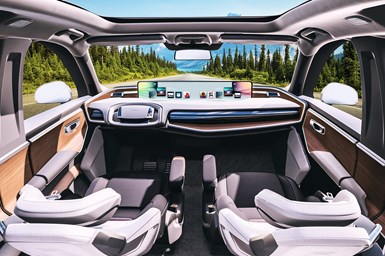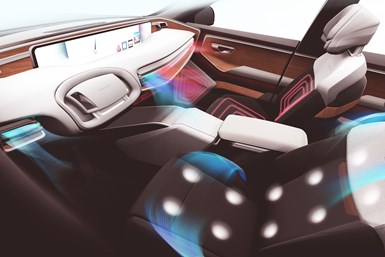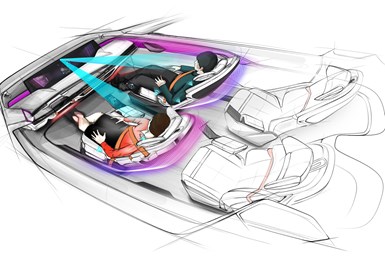Faurecia's Interior Rx
The cockpit of the future promises to be a comfortable, highly personalized and healthy experience.
#interior
Flexible seating. Comfort. Personalization. Immersive audio systems. Intuitive user interfaces. Entertainment and work spaces.
They’re all part of Faurecia’s vision for the cockpit of the future.

Faurecia expects various elements of its cockpit of the future concept to be introduced in production vehicles over the next three to five years. (Images: Faurecia)
The concept is being driven by advances in technology—including autonomous and connected vehicle systems—and changing consumer preferences. But many of the systems also are applicable to current vehicles, with motorists demanding a better experience as they spend more time on the road, interior specialist Faurecia notes.
Of course, future is a relative term. Most of Faurecia’s concepts fall into the near-term automotive spectrum, meaning they could start appearing in production models in 3-5 years. Others, such as smart surfaces that can integrate touch controls directly into a dashboard material, are ready as soon as a customer can design them into a vehicle.
Flexible Controls
The key is to provide value, rather than adding technology for its own sake. “We could line the entire interior with sensors, but it doesn’t mean we should,” notes Todd Fletemier, vice president of Midwest technology platforms at Faurecia’s North American headquarters in Auburn Hills, Mich. “We found it’s better to focus on one area, the center stack, where we can eliminate some buttons and provide a simplified approach with a smart surface.”
Faurecia also is developing a smartphone app that would allow users to control various vehicle systems through their phone, acting as universal controller of sorts. Such a device would be particularly handy for reconfigurable seating designs that can be adapted for different uses (driving, work, entertainment or relaxing) in future Level 3-5 autonomous vehicles, Fletemier says.
Future cockpits also could include adaptive dashboards, in which the function, size and shape of displays can be reconfigured on the fly. If the vehicle is operating in autonomous mode, for example, the dash becomes one large infotainment screen that everyone can see.
Personalization
In addition to providing shared experiences, interiors also need to be highly customizable to optimize each occupant’s experience. It all starts when a person enters the vehicle. Cameras will record each person’s measurements and adjust their seats and other parameters accordingly.
Personal preferences for the infotainment settings also are stored and updated. This could include everything from audio playlists to connected shopping services and integrated trip planning. For example, Fletemier says, the navigation system could suggest stopping at a nearby point of interest that a friend or celebrity that a user follows on social media recently visited or recommended.
Thermal Management
Next-generation climate control systems will combine current technologies (ventilation, thermal seat management and HVAC zone controllers) with advanced controls and smart materials that are able to absorb and release heat when and where it’s needed.

More precise airflow and thermal seat management can create a comfort bubble for each passenger.
This can be achieved by monitoring an occupant’s temperature and more effectively controlling airflow—without interfering with the comfort of adjacent passengers—and the surface temperatures of potential touchpoints, according to the supplier. In addition to improving personal comfort, Fletemier says the technology is more energy efficient because it only heats and cools the areas directly surrounding an occupant.
Body temperatures can be approximated via thermal imaging or seat sensors. Biometric sensors also could be used to monitor how sensitive a person is to temperature changes by changes in their heart rate. Such information could then be incorporated into an artificial intelligence-based processor to anticipate user preferences as conditions change.
Faurecia is developing the technology with Mahle. Commercialization is targeted within five years.
Sound Bubble
Faurecia also is developing an advanced audio system. The technology teams a seat-based bass with speakers integrated in the headrests and door panels to be closer to an occupant’s ears.
The system is designed with shared mobility in mind so that individuals can have private phone conversations or listen to music without interfering with each. Dynamic active noise cancelation based on a person’s head position also could be used to help create a “sound bubble” for each passenger. Some elements of the system are expected to be in production by 2023.
Connected Wellness
The coronavirus pandemic underscores the importance of maintaining a healthy environment. But Faurecia’s approach goes well beyond advanced filtration systems and keeping surfaces clean.

Sensors constantly monitor biometrics and adjust vehicle settings to optimize comfort or alert passengers to changing conditions.
The company’s comprehensive approach includes biometric sensors, adaptive features and countermeasures to optimize comfort while mitigating motion sickness, stress, discomfort and drowsiness. This could include adjusting the seat position, seat ventilation, changes in ambient lighting and even massage functions.
“One of our goals is that passengers feel better when they get out of a vehicle than we they entered it,” Fletemier explains, noting that nearly one-fifth of all accidents are caused by a medical event.
It’s not just about applying personal settings. To be effective, the system has to be dynamic, such as making adjustments if a person begin to slouch in their seat, Fletemier says. At the same time, he adds, the system needs to recognize and adapt to subjective metrics and varying comfort/discomfort levels.
Faurecia also is partnering with medical experts to better understand physiology, how to detect potential health problems and apply effective countermeasures. “It’s easy to measure a person’s heart rate. But we need to make sure we’re putting the information to good use and validating to medical standards,” Fletemier says.
RELATED CONTENT
-
2019 Volvo XC40 T5 AWD Momentum and R-Design
Back in 2004, Volvo introduced a concept vehicle, called “Your Concept Vehicle,” in which case the pronoun essentially referred to women because as the company pointed out, the YCC was “the first car designed and developed almost exclusively by women.” Some would say that Volvo was ahead of its time—way ahead—with this idea.
-
Lincoln Corsair Takes Flight
“We wanted to create a dramatic, youthful Lincoln with terrific harmony.” And with the Corsair, they’ve accomplished what they set out to do.
-
About the 2020 Lincoln Aviator
Successful vehicles tend to be those that are available on a global basis, and increasingly, those vehicles tend to be in the SUV segment writ large.

